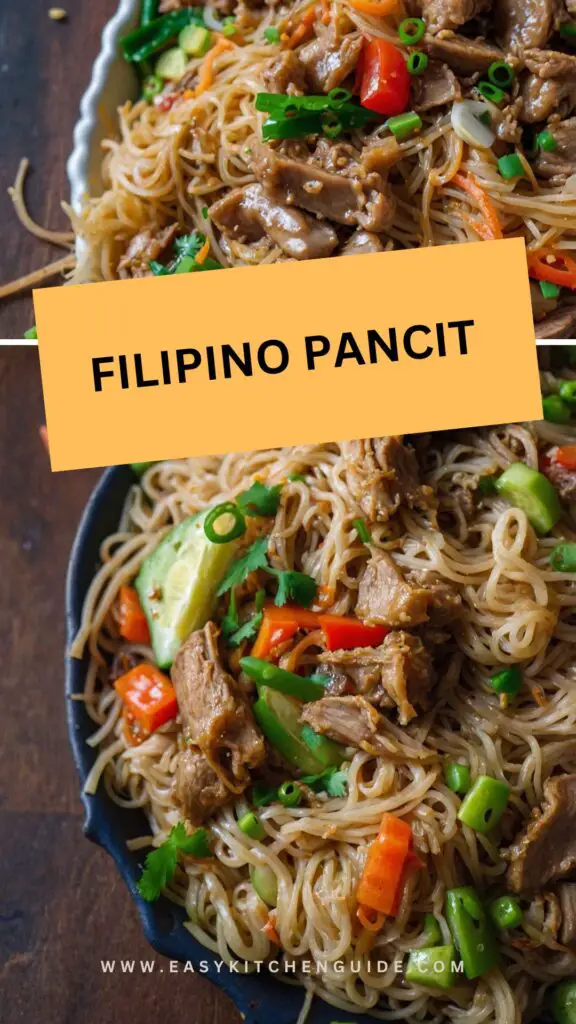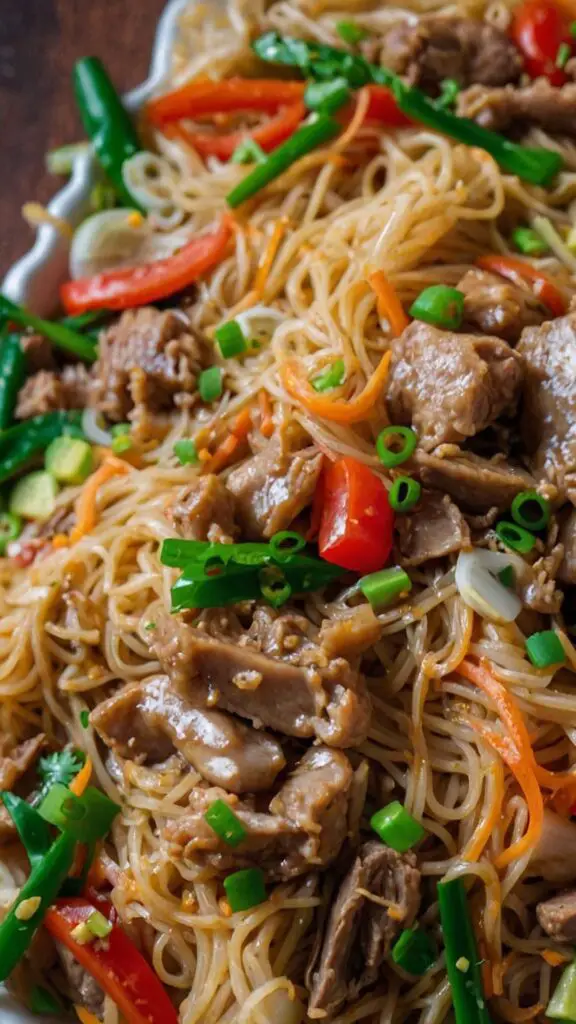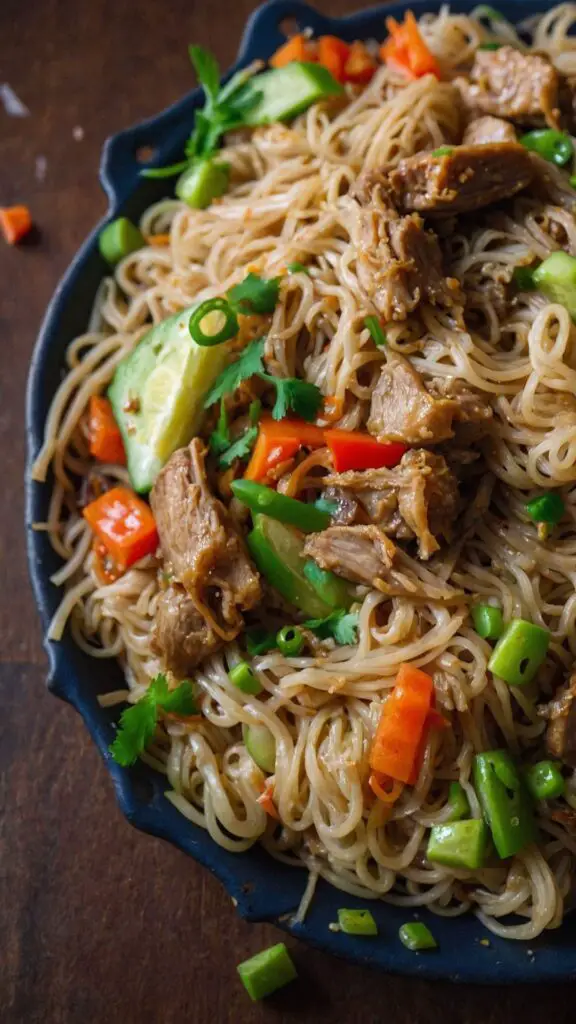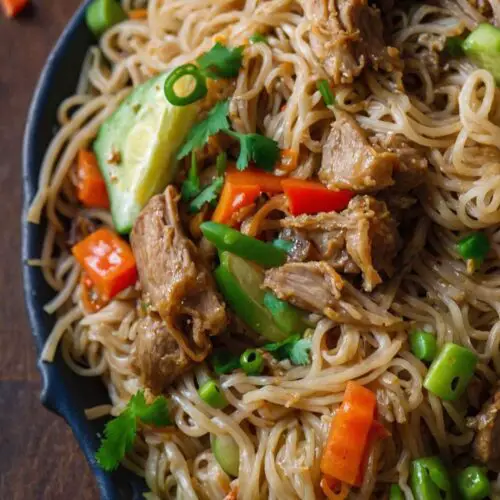If you’ve ever sat down to enjoy Filipino Pancit, you’ll know that this classic dish begs for accompaniments. You could pair it with lumpia, those crispy, golden fried spring rolls that offer a delightful crunch. Perhaps a side of adobo, which brings its own richness with tender, marinated meat and a tangy sauce?
If you’re feeling adventurous, consider a fresh green salad tossed in a tangy vinaigrette, cutting through the noodles’ savory depth. And don’t forget a chilled glass of calamansi juice—it adds a citrusy zing that complements the dish beautifully.

Growing up in a Filipino household, food was never just about sustenance. It was an experience loaded with connection and culture. One dish that takes me straight back to family gatherings is Pancit. This noodle dish represents so many joyful memories—birthdays, holidays, or just the feeling of home.
Pancit is not just a dish; it’s a celebration on a plate. Friends and family gathered around tables, laughter mixing with the tantalizing aroma wafting from the kitchen. Allow me to share the warmth of this comforting dish and guide you in crafting your own Filipino Pancit masterpiece.
What is Filipino Pancit?
Filipino Pancit is a noodle dish celebrated across the Philippines. Essentially, various types of noodles serve as the base, often mingling with an assortment of proteins and vegetables. It captures the essence of homemade cooking, each plate telling its own story depending on regional variations or family traditions.
The word “pancit” comes from the Hokkien word “pian e sit,” which means “convenient food.” This is exactly what Pancit embodies, making it a staple in Filipino cuisine. It’s versatile, colorful, and a crowd-pleaser not limited to occasions.
What Does It Taste Like?
The flavor profile of Pancit can be a delightful surprise for newcomers. Each bite reveals a chorus of tastes—savory, nutty, with a hint of sweetness and a subtle umami kick. Despite the complexity, it manages to remain comfortingly familiar.
The noodles soak up rich flavors from the broth, and the vegetables crackle with fresh brightness. It’s a well-balanced dish where every ingredient sings in harmony.
You will also like the following Lunch recipes!
- Chinese Cashew Chicken
- How to make Chicken Pot Pie With Biscuits
- Brown Butter Scallops Parmesan Risotto
Why This Recipe Works?
Let me dig into why this Pancit recipe is set to impress. Cookbook authors and seasoned chefs alike will tell you the success of a dish often lies in its foundation. Here are four key reasons why this Pancit recipe shines bright.
- Fresh Ingredients Matter
Using fresh vegetables and quality proteins enhances the overall flavor. The vibrant crunch of cabbage, along with the slight zing from ginger, infuses depth into the dish. No tired, wilted greens here! - Flavorful Broth Base
The use of homemade or good-quality chicken broth over plain water brings richness to the pasta. It elevates the taste, setting the stage for every bite to resonate with savory goodness. - Versatility with Noodles
This recipe allows flexibility. You can use rice noodles, egg noodles, or even whole wheat varieties—whatever suits your preference. Each kind may introduce different characteristics while still delivering that sought-after Pancit experience. - Balanced Cooking Technique
The way we cook Pancit matters deeply. Sautéing the garlic and onion releases their natural sweetness, while adding vegetables at the right moment ensures they remain bright and crisp. It’s all about timing and technique in achieving a perfect blend of flavors and textures.
Ingredients for Filipino Pancit
Ready to create some magic in your kitchen? Here’s a list of what you’ll need:
- 1 pound pork loin chops, cut into bite-sized pieces (about 4 chops)
- 1 package (8.8 oz) Thai vermicelli rice noodles
- 6 garlic cloves, minced
- 2 tablespoons neutral oil (such as canola or vegetable oil)
- 1 medium yellow onion, finely chopped
- 1 cup homemade or store-bought chicken broth
- 2 cups thinly shredded green cabbage
- 3 scallions, sliced
- 2 tablespoons tamari or low-sodium soy sauce
- ½ cup julienned carrots
- Kosher salt and freshly cracked black pepper, to taste
- 1 teaspoon toasted sesame oil (for a subtle nutty aroma)
- 1 tablespoon freshly grated ginger (adds a fresh zing)

Step-by-Step Instructions
Now, let’s dive into the process of crafting this delightful dish.
Step 1: Prepare the Noodles
Start by cooking the rice noodles according to the package instructions. If using vermicelli, this typically involves soaking them in hot water for several minutes until they are tender. Drain and set aside.
Step 2: Sauté the Aromatics
In a large pan, heat the neutral oil over medium heat. Add minced garlic and finely chopped onions. Stir them gently until the onions turn translucent, and you can smell that wonderful aroma. This usually takes about 3-4 minutes.
Step 3: Add the Pork
Once the onions are ready, toss in the pork pieces. Cook until browned, stirring occasionally. This will take about 5-7 minutes. You want that meat to get a good sear, which adds depth to the dish.
Step 4: Pour in the Broth
Now, add your homemade or store-bought chicken broth. Bring it to a gentle simmer, allowing the pork to absorb the broth’s flavor. Let it simmer for about 10 minutes.
Step 5: Add the Vegetables
Add in the shredded cabbage, julienned carrots, sliced scallions, and grated ginger. Stir everything together, allowing the veggies to soften while maintaining some crunch. Cook for another 5 minutes.
Step 6: Mix in the Noodles
Gently add the noodles to the pan. Toss them with the meat and vegetables, ensuring they soak up the tasty broth. Drizzle the tamari and toasted sesame oil over the mixture. Taste and season with salt and pepper as desired.
Step 7: Serve Hot
Once everything is perfectly combined and heated through, serve the Pancit hot. Garnish with extra scallions if you like. Enjoy!
Notes
Here are a few tips to get the best out of your Pancit:
- Prep Ingredients Ahead: Chop all veggies and meat the day before. It saves time and lets flavors meld together.
- Don’t Overcook the Noodles: Noodles can become mushy if cooked too long. Aim for al dente.
- Experiment: Feel free to mix different proteins like shrimp, chicken, or tofu for an alternative twist.
- Don’t Skip on Seasoning: A splash more of tamari can bring out stronger flavors. Adjust according to taste.
- Leftover Love: Pancit tastes even better the next day!
Nutrition Information
Curious about what you’re consuming? Here’s a rough breakdown per serving (assuming 6 servings):
- Calories: Approximately 360
- Protein: 22g
- Total Fat: 12g
- Saturated Fat: 3g
- Carbohydrates: 40g
- Fiber: 3g
- Sugars: 2g

How to Store the Leftovers?
If you find yourself with extra Pancit, don’t worry! Here’s how to keep it fresh:
- Refrigeration: Place leftovers in an airtight container. They can last in the fridge for 3-4 days.
- Freezing: You can freeze Pancit, but it may alter the texture of the noodles. Just ensure you store it in a freezer-safe container.
- Reheating: When you’re ready to indulge again, reheat on the stove with a splash of water or broth. This helps revive those noodles.
Sides for Filipino Pancit
Looking to elevate your dining experience with some side dishes? Here are four delightful suggestions:
- Lumpia: These crispy spring rolls filled with meat or vegetables offer a crunchy contrast. A must-have at any gathering!
- Pinakbet: A rich vegetable stew with a mix of eggplant, squash, and bitter melon, served warm. It provides a colorful and nutritious addition to your meal.
- Chicken Adobo: This savory, tangy dish made with marinated chicken is a classic that enhances the meal with bold flavors.
- Fresh Salad: A light salad with a citrus dressing can balance the richness of the Pancit. Try cabbage, cucumber, and a squeeze of calamansi for freshness.
Alternative Choices for Ingredients
Not all ingredients might be accessible in your pantry. Here are four alternative suggestions:
- Protein: If pork isn’t available, use chicken, beef, or shrimp. Each protein will create a unique flavor profile.
- Noodles: No vermicelli? Spaghetti or whole wheat pasta can serve as great alternatives. Just adjust the cooking time as necessary.
- Vegetables: If cabbage is scarce, use bok choy or spinach. They add different textures yet still deliver a good crunch.
- Sauces: If tamari or soy sauce is unavailable, a splash of Worcestershire sauce can provide a nice umami flavor.

Filipino Pancit
Equipment
Ingredients
- 1 pound pork loin chops cut into bite-sized pieces (about 4 chops)
- 1 package 8.8 oz Thai vermicelli rice noodles
- 6 garlic cloves minced
- 2 tablespoons neutral oil such as canola or vegetable oil
- 1 medium yellow onion finely chopped
- 1 cup homemade or store-bought chicken broth
- 2 cups thinly shredded green cabbage
- 3 scallions sliced
- 2 tablespoons tamari or low-sodium soy sauce
- ½ cup julienned carrots
- Kosher salt and freshly cracked black pepper to taste
- 1 teaspoon toasted sesame oil for a subtle nutty aroma
- 1 tablespoon freshly grated ginger adds a fresh zing
Instructions
Step 1: Prepare the Noodles
- Start by cooking the rice noodles according to the package instructions. If using vermicelli, this typically involves soaking them in hot water for several minutes until they are tender. Drain and set aside.
Step 2: Sauté the Aromatics
- In a large pan, heat the neutral oil over medium heat. Add minced garlic and finely chopped onions. Stir them gently until the onions turn translucent, and you can smell that wonderful aroma. This usually takes about 3-4 minutes.
Step 3: Add the Pork
- Once the onions are ready, toss in the pork pieces. Cook until browned, stirring occasionally. This will take about 5-7 minutes. You want that meat to get a good sear, which adds depth to the dish.
Step 4: Pour in the Broth
- Now, add your homemade or store-bought chicken broth. Bring it to a gentle simmer, allowing the pork to absorb the broth’s flavor. Let it simmer for about 10 minutes.
Step 5: Add the Vegetables
- Add in the shredded cabbage, julienned carrots, sliced scallions, and grated ginger. Stir everything together, allowing the veggies to soften while maintaining some crunch. Cook for another 5 minutes.
Step 6: Mix in the Noodles
- Gently add the noodles to the pan. Toss them with the meat and vegetables, ensuring they soak up the tasty broth. Drizzle the tamari and toasted sesame oil over the mixture. Taste and season with salt and pepper as desired.
Step 7: Serve Hot
- Once everything is perfectly combined and heated through, serve the Pancit hot. Garnish with extra scallions if you like. Enjoy!
Notes
- Prep Ingredients Ahead: Chop all veggies and meat the day before. It saves time and lets flavors meld together.
- Don’t Overcook the Noodles: Noodles can become mushy if cooked too long. Aim for al dente.
- Experiment: Feel free to mix different proteins like shrimp, chicken, or tofu for an alternative twist.
- Don’t Skip on Seasoning: A splash more of tamari can bring out stronger flavors. Adjust according to taste.
- Leftover Love: Pancit tastes even better the next day!
Frequently Asked Questions
1. Can I make Pancit Vegetarian?
Absolutely! Just replace the pork with tofu or more vegetables. You can also use vegetable broth instead of chicken broth for added depth.
2. Is Pancit gluten-free?
Using rice noodles ensures it’s naturally gluten-free. Always check the noodle package for any potential gluten content.
3. How do I make Pancit ahead of time?
You can prep all the ingredients and even cook the Pancit a day in advance. Just reheat gently before serving.
4. What occasions are Pancit served?
Pancit is commonly served at birthdays and celebrations because it symbolizes long life. However, it’s perfectly fine to enjoy it on any day!
Conclusion
Pancit is more than just a dish; it’s a reflection of culture and community. It’s not only about flavors but also the stories shared around the table. Through this recipe, I hope you’re inspired to create your own moments of joy with Filipino Pancit. Bring your loved ones together, savor the flavors, and revel in the connections made over this beloved dish. Enjoy the cooking journey!
You’ll also like these latest recipes!
My name is Lori Walker. I’m a registered dietitian, food blogger and food enthusiast. I share easy healthy, delicious recipes on my blog and review necessary kitchen items. The recipes I share take less… Read more
